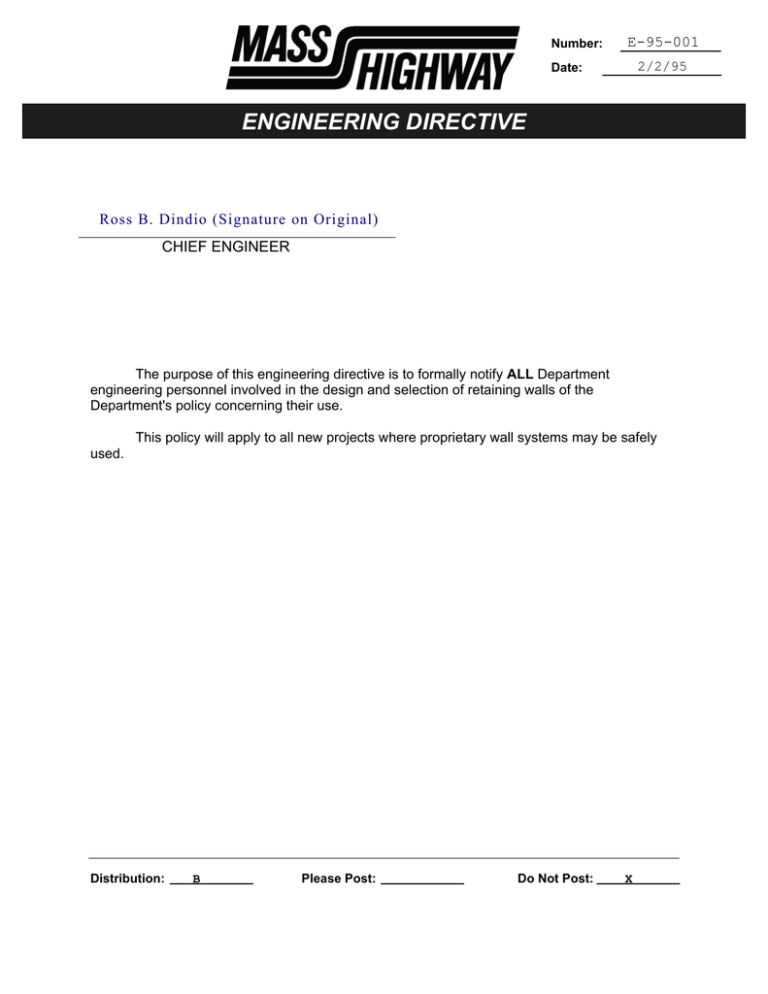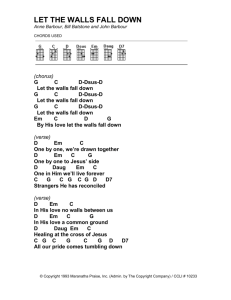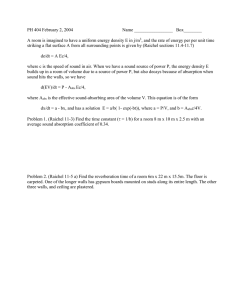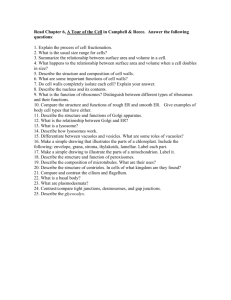ENGINEERING DIRECTIVE E-95-001 CHIEF ENGINEER
advertisement

Number: E-95-001 2/2/95 Date: ENGINEERING DIRECTIVE R oss B. Dindio (Signature on Original) CHIEF ENGINEER The purpose of this engineering directive is to formally notify ALL Department engineering personnel involved in the design and selection of retaining walls of the Department's policy concerning their use. This policy will apply to all new projects where proprietary wall systems may be safely used. Distribution: B Please Post: Do Not Post: X HE 12/15/94 MASSACHUSETTS HIGHWAY DEPARTMENT POLICY FOR PROPRIETARY WALL SYSTEMS PURPOSE The purpose of this document is to provide a systematic policy which will enable the Massachusetts Highway Department to better utilize proprietary wall systems. The document is based on FHWA guidelines and provides information for the consistent selection, review and acceptance of proprietary walls. The sections of the document are as follows: 1.0 A pre-approval process which will establish an approved list of proprietary walls. The list will contain several categories of walls. A checklist of the various items for technical consideration and required submittal for acceptance of wall systems is given. 2.0 An informational guideline by which to select one or more of the wall categories for a given project. 3.0 A standardized P.S.& E. format for proprietary wall systems. 4.0 A checklist for required submittal by the contractor. 5.0 An informational guideline delineating the responsibility for the selection, preparation of plans and shop drawing review for proprietary wall systems. Wall Policy, Page 2 1.0 PRE-APPROVAL Not all wall systems are suitable for Department projects. Preliminary Department approval of different wall systems prior to preparation of contract documents eliminates the use of substandard systems and systems that have not been adequately evaluated. A pre-approved list also provides contractors a more concise description of the proposed wall system(s) and hence a more accurate bid. The criteria for appointment to an approved list are as follows: 1.1 The supplier must have a Department approved manufacturing facility to fabricate the necessary wall components. 1.2 The wall system has a sound theoretical and practical basis for the Department to evaluate its claimed performance. 1.3 Past experience in building and performance of the proposed system. 1.4 The supplier or wall manufacturer should submit a package which contains the following items: a) How and when the wall was developed, system theory, laboratory and field experiments which support the theory or wall design. b) Practical applications with descriptions, photos and a list of users including names, addresses and phone numbers. c) Maximum height, surcharge, and backslope that the supplier is seeking approval for. d) Details of wall elements, analysis of structural elements, design calculations, special designs for impact loads, surcharges, abutments and corner and skew details. e) Estimated design life, corrosion design, procedures for field and laboratory evaluation of corrosion, corrosivity, durability and long term performance including special requirements. f) Maximum tolerable differential settlements within the wall and between the wall facing elements. g) Sample material and construction control specifications showing material type, quality, certifications, field testing, acceptance and rejection criteria and installation procedures. h) Facing panel or block dimensions, tolerance, geometry and weight, details of how they fit together; shear strength and long term durability of alignment pins, shear lips; compressive strength, freeze thaw resistance and moisture absorption characteristics of facing blocks or panels. i) For reinforcement for MSE walls - macrostructure, metals, coatings or polymers used; ultimate tensile strength; 10,000 hour creep test data at multiple load levels and temperatures; chemical, biological and microstructural degradation data that can be used to estimate long-term strength losses during the design life. j) A well documented field construction manual describing in detail, with illustrations as needed, the step by step construction sequence. k) Typical unit costs, supported by data from actual projects given in b) above. l) Details of no-dig zones, warning markers or other protective measures. Wall Policy, Page 3 The pre-approval submission will be reviewed by the Research and Materials Section, Geotechnical Section and Bridge Section with regard to the design, construction practicality and anticipated performance of the system. the Department's acceptance or rejection, with technical comments, will be provided by written notification from the Research and Materials Engineer. The Research and Materials Engineer will maintain this list. 2.0 WALL SELECTION 2.1 There are several categories of proprietary wall systems. The walls of each category have similar characteristics, advantages and disadvantages. The general descriptions of the categories of walls on the pre-approved list are as follows: a) Precast Concrete Gravity Walls - consist of precast, interlocking reinforced concrete elements that are usually box shaped. These walls rely on the element weight and weight of the soil retained within each element for stability. Generally they are supported by a structural footing or thick leveling pad. These walls are easy to install, are quickly placed and may be aesthetically enhanced by use of various face treatments. b) Precast Concrete Counterfort and Cantilever Gravity Walls - consist of full height precast face panels which are structurally connected to a cast in place heel forming an L-type cantilever wall. For walls taller than 3 meters a counterfort tension member links the face panel to the cast in place heel. Alternatively, the heel and facing may be precast as a single unit. The wall facing and a portion of the heel is founded on a thick leveling pad. For stability these wall rely upon the weight of the backfill above the heel. c) Crib and Bin type Gravity Walls - consist of stacked and interlocking and/or bolted tiers of beams forming a rectangular bin in which backfill is placed to provide the weight needed for stability. The tiers of beams may consist of concrete, treated timber or steel in which case they are called binwalls. These walls are usually constructed without structural foundations, are somewhat flexible and will tolerate some differential settlement. Many are battered and may require special detailing when not on tangent alignments. Also, some are constructed with open facing to enhance drainage or wall plantings, others have facing that is easily climbed. d) Gabion Walls - consist of compartmented metallic mesh containers filled with stacked or dumped select rock or stone. Stability of these walls is achieved by the weight of the slone filled baskets. The walls are constructed without structural foundations and are quite flexible. These walls are aesthetically pleasing because they blend into areas of rugged terrain. The metallic mesh of the walls is susceptible to damage from impacts and vandalism. e) Pile Walls - include sheet piles and soldier pile and lagging systems with or without anchors. To achieve stability these walls rely on pile embedment and bending resistance of the pile, for walls greater that three meters in height horizontal anchors may be needed as well. These walls are best suited in cut situations and low height fill situations in very steep terrain. Also, In fill situations deadman anchors may be used, however, difficulties exist in filling over the anchor ties and controlling deflections of the wall face. f) MSE Walls with Inextensible Reinforcement - consist of metallic reinforcing elements attached to a facing consisting of precast concrete, timber, or stone filled wire mesh baskets. The walls derive their stability from the metallic reinforcement placed between lifts of the compacted backfill. They do not require a structural foundation and depending upon the type of facing can tolerate significant vertical and horizontal settlements. Construction is generally very rapid due to ease of backfilling these walls. Because of the required reinforcement length, these walls are more suitable for fill situations than for cut situations. Consideration of the location of future utilities is necessary for these walls. Wall Policy, Page 4 g) 2.2 3.0 MSE Walls with Extensible Reinforcement - are similar to the previous category. The difference being that the reinforcement elongates during wall installation. For this reason there are some difficulties maintaining wall face deflections. The long term durability of the polymer reinforcement is also a consideration. The decision to use a particular category(s) of walls for a specific project requires a determination of both technical feasibility and comparative economy of the wall categories listed above and the traditional cast-in-place or mortared stone walls. To develop 25% stage plans the Department and/or it's consultants should consider the following: a) Constructability - earthwork situation (cut or fill), length and height of the wall, complicated alignment or alignment changes, availability and cost of required backfill material, temporary excavation support, dewatering, construction sequence and maintenance of traffic. b) Foundation considerations - bearing capacity, slope stability, settlement (differential, total, long term), type of foundation required (deep, shallow or ground improvement), groundwater seepage conditions. c) Structural considerations - magnitude of loads, durability of components, utilities in backfill, drainage requirements, guardrail or barrier requirements, required maintenance. d) Aesthetics and environmental concerns. e) Cost considerations - comparison to alternatives in alignment of roadway, steepened slopes, availability of Right of Way, future uses. P.S.& E. PREPARATION For projects in which proprietary retaining structures are feasible the Department will issue a conceptual wall plan, a detailed set of wall drawings will not be contained in the bid documents. Only pre-approved walls will be allowed. 3.1 3.2 Geometric items: a) Beginning and end of wall stations. b) Elevation on top of wall at beginning and end of wall and all profile break points and roadway profile data at wall line. c) Original and proposed profiles in front of and behind the retaining wall. d) Cross sections at the retaining wall location at 50 foot intervals. e) Horizontal wall alignment for top of wall. f) Right of way limits. Design items: a) Wall category(s) from approved list to be allowed for the project (i.e. Precast Concrete Gravity, MSE-inextensible, e.t.c.). b) Construction sequence requirements, traffic control, access, and stage construction. Wall Policy, Page 5 3.3 c) Elevation(s) of highest permissible level for foundation construction. Location, depth and extent of any unsuitable material to be removed and replaced. Elevation of bedrock where encountered. d) Details of wall appurtenances including traffic barriers, fence, coping, drainage structures, details at abutting structures location and configuration of signs and lighting including conduit locations. e) Quantities table of estimated wall area and appurtenances. f) Extreme high water and normal water elevations, any measured groundwater elevations. g) Boring logs, allowable bearing capacity of foundation soils, minimum wall foundation embedment depth and maximum tolerable total and differential settlements. h) Design life of structure: temporary, permanent (75 or 100 years). i) Magnitude, location, direction and extent of external loads due to other structures, overhead signs and lights, traffic, groundwater and seismic coefficients. j) Limits and requirements for other structures beneath, behind or through the retaining wall. k) Backfill requirements for both within and behind the retaining wall including gradation, electrochemical data, soundness, lift thickness, minimum density. I) Governing sections of design documents (AASHTO, ASTM, NCMA, Bridge Manual) to be used in determining internal and external stability, allowable stresses and material specifications. m) Horizontal and vertical wall face alignment tolerances (for example 10 mm per meter for MSE walls). n) Special wall facing finish, texture, color or plantings. Special Provisions Special provisions should list the required submittal discussed in section 4.0 below. Additionally, it should be stated that a representative of the wall manufacturer be at the site during construction of the wall, and that a manufacturer's 'manual detailing the construction sequence be provided to the Engineer. 3.4 Payment Items Payment should be per unit area of wall from the finished grade at the base of the wall to the wall top. Any appurtenances should be paid for separately. 3.5 Bidding Instructions In order to give suppliers of proprietary walls sufficient time to prepare bids and to enable reliable pricing, the presence of proprietary wall types should be included in the project description of the bid proposal. The wall category(s) permitted for the project should be shown and basic information such as length, height and area described. Reference should be made to the Department's list of pre-approved wall systems and only those listed may be used. 4.0 CHECKLIST OF REQUIRED SUBMITTAL Subsequent to contract award and a minimum of 90 days prior to proposed wall construction the contractor shall submit detailed design computations and all details, dimensions, quantities and cross Wall Policy, Page 6 sections necessary to construct the wall. The plans should include, but not be limited to, the following items: a) An elevation view of the wall indicating the elevation at bottom of footings, top of leveling pads, top of the wall, at all horizontal and vertical break points and at least every 50 feet along the wall. The distance along the face of the wall to any changes in: footing type, leveling pad or footing steps, type of module or panel, the length, size and number of reinforcement strips or mesh. The location of the original and final ground line at the base of the wall. b) A plan view of the wall showing: offset from the construction centerline to the face of the wall at all changes in horizontal alignment, the limit of the widest module, mesh or strap and any drainage structure or utility which is behind, passes under or through the wall. c) All horizontal and vertical curve data affecting construction. d) A listing of the summary of quantities including incidental items. e) Cross section showing limits of construction and in fill sections, limits and extent of select granular backfill placed. f) Limits and extent of reinforced soil volume (if MSE wall). g) Details of all modules and facing elements, reinforcing bar and bar bending details, soil reinforcement element attachment devices. ( h) All details for foundations or leveling pads as well as the allowable bearing pressures. i) Details for connections to traffic barriers, coping, parapets and attached lighting. j) Detailed design computations, including explanation of any symbols and computer programs used. k) All plans and calculations shall be in conformance with AASHTO and be stamped by a Professional Engineer licensed in Massachusetts. All designs and construction details will be checked and compared against the pre-approved design drawings and procedures ~or that particular system by the Department's consultant or Bridge Section and Geotechnical Section. Approval of the detailed design plans and notification to proceed shall be made by the Design Engineer. 4.1 Materials Prior to delivery of any material used in the retaining wall construction, the sources must be accepted in conformance with the Department specifications. Select granular backfill must be approved or tested for compliance prior to construction. Wall Policy, Page 7 5.0 DEPARTMENT AND DEPARTMENT'S CONSULTANT RESPONSIBILITY The following sequence outlines the organizational unit and necessary actions by that unit to select, coordinate and review designs and monitor construction of proprietary wall systems. 5.1 Pre-Approval Geotechnical Section - Reviews geotechnical aspects of wall supplier submission, with comments to Research and Materials Section. - Reviews structural aspects of wall supplier submission and provides comments to Research and Materials Section. Bridge Section Research and Materials Section Reviews materials aspects of wall supplier submission, compiles comments from Bridge and Geotechnical and provides approval or rejection with comments to supplier. Maintains pre-approved wall list. 5.2 Wall Selection District Office, Bridge Section, Highway Design or Consultant - Determines need for a retaining wall at a specific location. - Determines particular project constraints, environmental, aesthetic or special site conditions. - Requests Geotechnical recommendations concerning walls. Geotechnical Section or Consultant Perform Subsurface investigation and prepare Geotechnical Report with recommendations for wall design and construction. District Office, Bridge Section, Highway Design or Consultant - 5.3 Based on Geotechnical Report, special site conditions and cost comparison, selects wall alternates to be allowed. If a masonry or cast in place type walls are acceptable use standard drawings. For other wall types follow procedures outlined above. Coordinate preparation of conceptual plan as outlined in section 3.0. Post Award Design and Plan Review Construction Section - The contractor forwards the proposed wall design to the Design Engineer for review in accordance with section 4.0. After approval the contractor will submit the original mylar(s), for the Department's permanent records, and six (6) copies to the Design Engineer for distribution to the District (2), Research and Materials Engineer (1), Design Engineer (1), Bridge Engineer (1), Geotechnical Engineer (1). 5.4 Construction Continue use of current Department procedures (see also Section 4.1).







